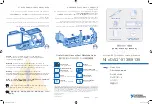
Using iLO 2 113
3.
Click
Connect.
To use an image file:
1.
Select
Local Image File
within the Virtual CD/DVD-ROM section of the Virtual Media applet.
2.
Enter the path or file name of the image in the text box or click
Browse
to locate the image file using
the Choose Disk Image File dialog.
3.
Click
Connect.
The connected drive icon and LED will change state to reflect the current status of the Virtual CD/DVD-
ROM. When connected, virtual devices are available to the host server until you close the Virtual Media
applet. When you are finished using the Virtual CD/DVD-ROM, you can choose to disconnect the device
from the host server or close the applet. The Virtual Media applet must remain open when using a Virtual
Media Device.
iLO 2 Virtual Media CD/DVD-ROM will be available to the host server at run time if the operating system
on the host server supports USB floppy drives. Refer to "Operating system USB support (on page
110
)"
for information on which operating systems support USB mass storage at the time of the publication of this
manual.
iLO 2 Virtual Media CD/DVD-ROM appears to your operating system just like any other CD/DVD-ROM.
When using iLO 2 for the first time, the host operating system may prompt you to complete a New
Hardware Found wizard.
When you are finished using iLO 2 virtual media and disconnect it, you might receive a warning message
from the host operating system regarding unsafe removal of a device. This warning can be avoided by
using the operating system-provided feature to stop the device before disconnecting it from the Virtual
Media.
Virtual Media CD/DVD-ROM operating system notes
•
MS-DOS
The virtual CD/DVD-ROM is not supported in MS-DOS.
•
Windows Server® 2008 and Windows Server® 2003
The virtual CD/DVD-ROM displays automatically after Windows® has recognized the mounting of
the USB device. Use it as you would a locally attached CD/DVD-ROM device.











































